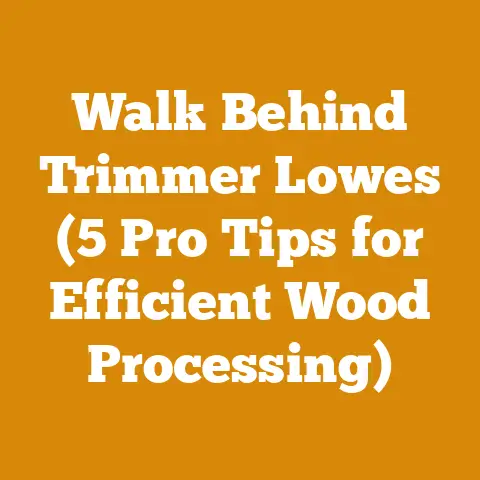Suburban Wood Burning Stove Prices (7 Insider Tips You’ll Want)
Fire Up Affordability: Cracking the Code to Suburban Wood Burning Stove Prices (7 Insider Tips You’ll Want!)
Choosing a wood-burning stove for your suburban home is a big decision, and let’s face it, the price tag can be a bit of a shocker. The truth is, navigating the pricing landscape can feel like hacking your way through a dense forest. But don’t worry, I’m here to give you the lay of the land with some insider tips to help you find the best stove for your budget.
1. Decoding the Base Price: What’s Really Included?
The first thing you’ll see is the base price of the stove. This is the manufacturer’s suggested retail price (MSRP), but it’s rarely what you’ll actually pay. Think of it as the starting point for negotiations. More importantly, understand what the base price doesn’t include. Often, it’s just the stove itself.
- Installation Costs: This is a big one. Installation can easily add hundreds, even thousands, to the final cost. It includes things like:
- Chimney Liner: A stainless-steel liner is crucial for safety and efficiency. Expect to pay anywhere from $500 to $2000+ depending on the height and complexity of your chimney.
- Permits: Local codes often require permits for wood stove installations. The cost varies widely by municipality, but budget around $50-$200.
- Professional Installation: Unless you’re a seasoned DIYer with a solid understanding of building codes, hire a certified installer. This ensures the stove is installed safely and efficiently. Labor costs can range from $500 to $1500 or more.
- Accessories: These can add up quickly:
- Hearth Pad: This protects your flooring from embers and heat. Prices range from $100 to $500+.
- Stovepipe: Connects the stove to the chimney liner. Expect to pay around $50-$150 per section.
- Tools: A poker, shovel, and ash bucket are essential. Budget around $50-$100.
Insider Tip: Always get a detailed quote from the dealer that breaks down all the costs, including installation and accessories. Don’t be afraid to ask questions and negotiate!
2. Size Matters: Right-Sizing Your Stove for Savings
Choosing the right size stove is crucial, not just for comfort but also for your wallet. An oversized stove will overheat your space and waste fuel, while an undersized stove will struggle to keep you warm.
- BTU (British Thermal Unit) Rating: This measures the stove’s heat output. As a general rule, you’ll need about 5,000 BTU per 200 square feet of living space. However, this is just a starting point.
- Factors Affecting Stove Size:
- Climate: Colder climates require larger stoves.
- Insulation: Well-insulated homes need less BTU output.
- Home Layout: Open floor plans are easier to heat than homes with many small rooms.
- Ceiling Height: Higher ceilings require more BTU output.
Case Study: I once advised a friend who was convinced he needed the biggest stove on the market. After assessing his well-insulated, 1,500-square-foot home, I convinced him a smaller, 40,000 BTU stove would be more than sufficient. He saved money on the stove itself and uses significantly less firewood each winter.
Insider Tip: Consult with a qualified dealer to determine the right size stove for your home. They can perform a heat loss calculation to ensure you’re not overspending.
3. Material World: Cast Iron vs. Steel – Price and Performance
The material your stove is made from significantly impacts its price and performance. The two main contenders are cast iron and steel.
- Cast Iron Stoves:
- Pros: Excellent heat retention, radiate heat more evenly, aesthetically pleasing, can last for generations with proper care.
- Cons: More expensive, heavier, more prone to cracking if overheated.
- Steel Stoves:
- Pros: Less expensive, lighter, heats up quickly, more resistant to cracking.
- Cons: Less heat retention, can fluctuate in temperature more quickly, may not last as long as cast iron.
Data Point: Cast iron stoves typically cost 20-50% more than comparable steel stoves.
Insider Tip: Consider your priorities. If you value aesthetics and even heat distribution and are willing to pay more, cast iron is a great choice. If you’re on a budget and prioritize quick heating, steel is a more practical option.
4. Efficiency Matters: Lower Emissions, Lower Bills
The efficiency of your stove directly impacts how much firewood you’ll burn and how much pollution you’ll release into the atmosphere. Look for stoves that are EPA-certified and have a high efficiency rating.
- EPA Certification: The Environmental Protection Agency (EPA) sets emission standards for wood stoves. Stoves that meet these standards are cleaner-burning and more efficient.
- Efficiency Rating: This indicates how much of the wood’s energy is converted into usable heat. Higher efficiency ratings mean you’ll burn less wood to achieve the same level of warmth. Look for stoves with an efficiency rating of 75% or higher.
- Catalytic vs. Non-Catalytic Stoves:
- Catalytic Stoves: Use a catalyst to burn off pollutants, resulting in lower emissions and higher efficiency. They typically require more maintenance and the catalyst needs to be replaced every few years.
- Non-Catalytic Stoves: Rely on advanced combustion technology to reduce emissions. They are generally less expensive and require less maintenance than catalytic stoves.
Insider Tip: While catalytic stoves are more efficient, the cost of replacing the catalyst can offset the fuel savings. Consider your budget and maintenance preferences when choosing between the two.
5. Shop Around: Comparison is Key
Don’t settle for the first stove you see. Shop around and compare prices from different dealers.
- Online vs. Local Dealers: Online retailers often offer lower prices, but you’ll miss out on the personalized service and installation expertise of a local dealer.
- Negotiate: Don’t be afraid to negotiate the price. Dealers are often willing to offer discounts, especially during the off-season (spring and summer).
- Consider Used Stoves: You can often find used stoves in good condition for a fraction of the price of a new one. However, be sure to inspect the stove carefully for damage and ensure it meets current EPA standards.
Insider Tip: Check online forums and classifieds for used stoves. You might find a hidden gem! Just be sure to have it inspected by a professional before installing it.
6. Timing is Everything: Seasonal Savings
The time of year you purchase your stove can significantly impact the price.
- Off-Season Purchases (Spring/Summer): Dealers are often more willing to offer discounts during the off-season when demand is lower. They’re eager to clear out inventory to make room for new models.
- End-of-Year Sales: Some dealers offer year-end sales to reduce inventory before the new year.
- Clearance Sales: Keep an eye out for clearance sales on discontinued models.
Insider Tip: I once snagged a high-end cast iron stove for 40% off during a summer clearance sale. Patience and timing can pay off big time!
7. DIY vs. Professional Installation: Weighing the Risks and Rewards
Installing a wood stove yourself can save you money, but it’s not for the faint of heart. It requires a solid understanding of building codes, chimney systems, and safety regulations.
- Pros of DIY Installation:
- Cost Savings: You’ll save hundreds or even thousands of dollars on labor costs.
- Control: You have complete control over the installation process.
- Cons of DIY Installation:
- Safety Risks: Improper installation can lead to fire hazards and carbon monoxide poisoning.
- Code Violations: Installing a stove without proper permits or inspections can result in fines and require you to redo the installation.
- Warranty Issues: DIY installation may void the stove’s warranty.
Data Point: According to the National Fire Protection Association (NFPA), heating equipment is the second leading cause of home fires in the United States.
Insider Tip: Unless you’re a highly experienced DIYer with a thorough understanding of wood stove installation, it’s best to hire a certified professional. The peace of mind and safety are well worth the investment.
Bonus Tip: Wood Source & Preparation
Don’t forget about the ongoing cost of firewood! Sourcing affordable, seasoned firewood is crucial for keeping your heating costs down.
- Hardwood vs. Softwood: Hardwoods like oak, maple, and ash burn longer and hotter than softwoods like pine and fir.
- Seasoning: Firewood needs to be properly seasoned (dried) before burning. Freshly cut wood can have a moisture content of 50% or higher, which makes it difficult to burn and produces excessive smoke. Aim for a moisture content of 20% or less.
- Cord Volume: A cord of wood is a stack that measures 4 feet high, 4 feet wide, and 8 feet long. It contains approximately 128 cubic feet of wood.
Data Point: Burning unseasoned firewood can reduce your stove’s efficiency by as much as 50% and increase creosote buildup in your chimney.
Technical Requirements:
- Log Dimensions: Optimal log length for most stoves is 16-18 inches. Log diameter should be no more than 6-8 inches for efficient burning.
- Wood Moisture Content: Use a moisture meter to ensure firewood is properly seasoned. Ideal moisture content is below 20%.
- Tool Requirements: A good chainsaw is essential for cutting firewood. Ensure it is properly calibrated and maintained. A splitting maul or hydraulic wood splitter will make the job easier.
- Safety Equipment: Always wear safety glasses, gloves, and hearing protection when cutting firewood.
Wood Selection Criteria:
- Hardwoods: Oak, maple, ash, birch, beech. High density, long burn time, high heat output.
- Softwoods: Pine, fir, spruce, cedar. Lower density, shorter burn time, lower heat output, more resinous (can lead to more creosote buildup).
Tool Calibration Standards:
- Chainsaw Chain Tension: Check and adjust chain tension before each use. A properly tensioned chain should have minimal slack but still be able to be pulled around the bar by hand.
- Carburetor Adjustment: A properly adjusted carburetor ensures optimal fuel-air mixture. Refer to your chainsaw’s manual for specific adjustment procedures.
- Sharpening: Keep your chainsaw chain sharp for efficient cutting. Use a file and guide to maintain the correct cutting angle.
Safety Equipment Requirements:
- Safety Glasses: Protect your eyes from flying debris.
- Gloves: Protect your hands from cuts and splinters.
- Hearing Protection: Chainsaws can generate high noise levels. Wear earplugs or earmuffs to protect your hearing.
- Steel-Toed Boots: Protect your feet from falling logs and sharp objects.
- Chainsaw Chaps: Provide protection for your legs in case of a chainsaw kickback.
By following these insider tips, you can navigate the world of suburban wood-burning stove prices with confidence and find the perfect stove to keep you warm and cozy all winter long, without burning a hole in your wallet! Remember, a little research and planning can save you a lot of money in the long run. Happy heating!






